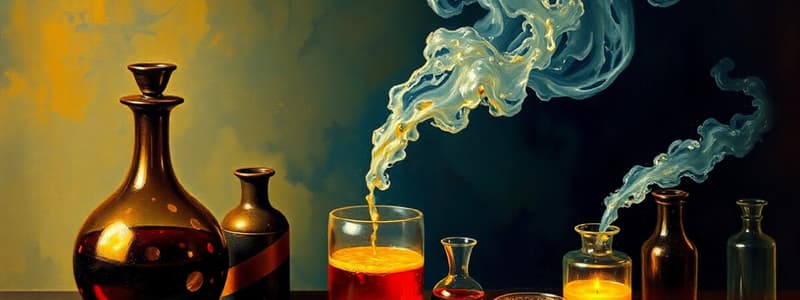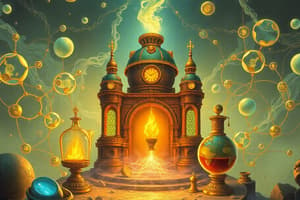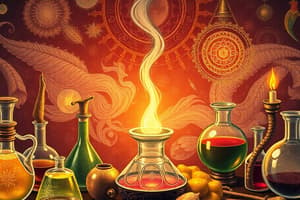Podcast
Questions and Answers
What is iatrochemistry?
What is iatrochemistry?
Iatrochemistry is a branch of chemistry and medicine, considered a precursor to biochemistry, that sought chemical explanations for physiological and pathological processes and aimed to treat diseases with chemical substances.
Iatrochemistry is considered the precursor to _____.
Iatrochemistry is considered the precursor to _____.
biochemistry
What does the Law of Conservation of Mass state?
What does the Law of Conservation of Mass state?
It states that in any chemical reaction, mass is conserved; the total mass of the reactants is equal to the total mass of the products. Matter is neither created nor destroyed, only transformed.
Who is considered the creator of modern chemistry?
Who is considered the creator of modern chemistry?
Match the branch of chemistry with its primary focus:
Match the branch of chemistry with its primary focus:
What is the formula for effective nuclear charge ($Z_{ef}$)?
What is the formula for effective nuclear charge ($Z_{ef}$)?
Effective nuclear charge ($Z_{ef}$) is the actual nuclear charge experienced by an electron, considering _____ by inner electrons.
Effective nuclear charge ($Z_{ef}$) is the actual nuclear charge experienced by an electron, considering _____ by inner electrons.
What is the first ionization energy?
What is the first ionization energy?
Metals tend to form _____, while nonmetals tend to form _____.
Metals tend to form _____, while nonmetals tend to form _____.
Cations are _____ than the atoms they originate from.
Cations are _____ than the atoms they originate from.
Define electron affinity.
Define electron affinity.
Match the state of matter with its description:
Match the state of matter with its description:
Water is considered an anomaly compared to other hydrides like H2S or H2Te regarding its boiling point due to _____.
Water is considered an anomaly compared to other hydrides like H2S or H2Te regarding its boiling point due to _____.
What distinguishes a covalent network solid, like diamond, from a molecular solid, like ice?
What distinguishes a covalent network solid, like diamond, from a molecular solid, like ice?
In metals, valence electrons are _____.
In metals, valence electrons are _____.
List three characteristic properties of gases.
List three characteristic properties of gases.
Define pressure and give its formula.
Define pressure and give its formula.
What is standard atmospheric pressure at sea level equal to in torr and atm?
What is standard atmospheric pressure at sea level equal to in torr and atm?
What is the mathematical relationship described by Boyle's Law?
What is the mathematical relationship described by Boyle's Law?
State Charles's Law.
State Charles's Law.
Write the Ideal Gas Law equation and define its terms.
Write the Ideal Gas Law equation and define its terms.
What is the purpose of the van der Waals equation?
What is the purpose of the van der Waals equation?
According to the kinetic-molecular theory, the average kinetic energy of gas molecules is directly proportional to the _____.
According to the kinetic-molecular theory, the average kinetic energy of gas molecules is directly proportional to the _____.
Define effusion.
Define effusion.
Under what conditions do real gases behave most like ideal gases?
Under what conditions do real gases behave most like ideal gases?
Flashcards
Iatrochemistry
Iatrochemistry
Alchemy-based medical chemistry seeking chemical explanations for pathological and physiological processes, aiming to treat diseases with chemicals.
Law of Conservation of Mass
Law of Conservation of Mass
A fundamental principle in chemistry stating that mass is conserved in chemical reactions.
Biochemistry
Biochemistry
The study of substances and processes occurring in living organisms.
Astrochemistry
Astrochemistry
Signup and view all the flashcards
Effective Nuclear Charge
Effective Nuclear Charge
Signup and view all the flashcards
Electron Affinity
Electron Affinity
Signup and view all the flashcards
Red Covalent Solids
Red Covalent Solids
Signup and view all the flashcards
Pressure
Pressure
Signup and view all the flashcards
Boyle's Law
Boyle's Law
Signup and view all the flashcards
Charles's Law
Charles's Law
Signup and view all the flashcards
Ideal Gas Law
Ideal Gas Law
Signup and view all the flashcards
Van der Waals Equation
Van der Waals Equation
Signup and view all the flashcards
Graham's Law
Graham's Law
Signup and view all the flashcards
Study Notes
- The history of chemistry includes the primitive era, the Greeks, alchemy, iatrochemistry, the phlogiston theory, and modern chemistry.
- Primitive era chemistry involved the use of fire, gunpowder, and metal extraction.
- The Greeks proposed four elements and the atomic theory.
- Alchemy in Egypt and Mesopotamia sought the philosopher's stone.
- Iatrochemistry focused on medical chemistry and experimental methods.
- The phlogiston theory involved the substance of fire.
- Modern chemistry includes oxidation, atomic theory, molecules, the periodic table, chemical equilibrium, acids, bases, and radiation.
Branches of Chemistry
- Nano chemistry
- Petrochemistry
- Preparative chemistry
- Chemiurgy
- Astrochemistry
- Quantum chemistry
- Analytical chemistry
- Biochemistry
- Physical chemistry
- Industrial chemistry
- Environmental chemistry
- Crystallochemistry
- Pharmaceutical chemistry
Chemical Products
- The discovery of elements, compounds, and other important products.
- Examples include gunpowder (saltpeter, sulfur, charcoal).
- Greek Fire (quicklime, petroleum, sulfur).
- Phosphorus
- Alum
- Ammonia
- Sulfuric acid
- Nitric acid
- Sodium hydroxide
Iatrochemistry (XVI Century)
- Iatrochemistry is a fusion of chemistry and medicine
- It seeks chemical explanations for pathological and physiological processes of the human body.
- It aims to provide treatments with chemical substances.
- It is considered the precursor of biochemistry.
- Paracelsus, a Swiss alchemist, was a key leader and founder of iatrochemistry.
- Iatrochemists believed physiology depended on fluid balance in specific bodily fluids.
Utensils
- Alchemists introduced valuable experimentation instruments.
- Examples include the balance, alembic, and crucible.
Law of Conservation of Mass
- The law of conservation of mass states that mass is conserved in chemical reactions.
- The mass of the reactants consumed equals the mass of the products obtained.
- Mass is never created or destroyed, only transformed and remains invariable.
Lavoisier
- Antoine Lavoisier, also known as the Newton of chemistry, is considered the creator of modern chemistry.
- He conducted detailed studies on oxidation of bodies, animal respiration, air analysis, the use of the balance to establish quantitative relationships in chemical reactions, and calorimetry studies.
- Lavoisier established his famous law of conservation of mass.
- Lavoisier's work clarified confusion among chemists and led to advancements in chemistry.
Organic Chemistry
- Studies compounds containing carbon/hydrogen bonds e.g. hydrocarbons, polymers, and proteins.
- Covers all natural elements and organic tissues.
- Provides solutions for life quality improvement in areas like hygiene and health.
Inorganic Chemistry
- Studies the formation, composition, structure, and chemical reactions of inorganic elements and compounds.
- Inorganic elements and compounds do not contain carbon/hydrogen bonds e.g. metals, minerals, or ceramic materials.
- Applications include fiber optics, concrete, and electronic chips.
Analytical Chemistry
- Studies the chemical composition of a material or sample through different laboratory methods.
Engineering Chemistry
- This is a branch of engineering that develops industrial processes for the transformation of matter and designs new materials.
- The processes require sophisticated physical and chemical transformations of matter.
Biochemistry
- Examines substances present in living organisms such as plants, animals, microorganisms, or humans.
Physical Chemistry
- It studies matter and its transformations applying physical concepts like movement, time, energy, and forces.
Astrochemistry
- Studies the composition of material elements found in the universe
- Examples include stars, planets, or comets.
Pharmaceutical Chemistry
- Studies molecules for the development of medications.
- The goal is to combat or alleviate diseases.
Electrochemistry
- It analyzes the relationship between chemical reactions and electricity.
Environmental Chemistry
- Studies chemical processes in the environment (soil, water, atmosphere) and the impact of human activities.
The Periodic Table
- Dmitri Mendeleev and Lothar Meyer reached similar conclusions independently on how elements should be grouped.
Effective Nuclear Charge
- In a polyelectronic atom, electrons are attracted to the nucleus and repelled by other electrons.
- The nuclear charge an electron experiences depends on both factors.
- The effective nuclear charge, Zeff, is found as Zeff = Z - S where Z is the atomic number and S is a screening constant, generally close to the number of inner electrons.
Ionization Energy
- Metals tend to form cations.
- Non-metals tend to form anions.
- The first ionization energy is the energy required to remove the first electron.
- The second ionization energy is the energy required to remove the second electron.
- Cations are smaller than the atoms from which they originate.
- The outermost electron is removed, reducing repulsion between electrons.
Electron Affinity
- Electron affinity is the change in energy when an electron is added to a gaseous atom.
States of Matter
- Gas: Adopts the volume and shape of its container, compressible, flows easily, diffuses rapidly.
- Liquid: Adopts the shape of the part of the container it occupies, incompressible, flows easily, diffuses slowly.
- Solid: Maintains its own shape and volume, incompressible, does not flow, diffuses extremely slowly.
Hydrogen bonding
- Observe high critical temperatures and pressures. This is due to the intensity of the Van der Waals forces between water molecules.
Crystalline Solids
- Types of crystalline solids include primitive cubic, body-centered cubic, and face-centered cubic.
- In crystalline solids, atoms or molecules are arranged in a regular, repeating pattern
Types of solids
- Molecular solids: held together by intermolecular forces, have low melting points
- Covalent network solids: held together by covalent bonds, have high melting points and are very hard
- Ionic solids: held together by ionic bonds, have high melting points and are brittle
- Metallic solids: have a sea of electrons, have high melting points and are ductile and malleable
Properties of gases
- Expand to fill their container
- Highly compressible
- Extremely low density
Pressure
- Pressure is the amount of force applied to an area.
- Atmospheric pressure is the weight of air per unit area.
- Commonly used units of pressure are Pascals, Bars and atm
Manometer
- A manometer is a measuring instrument used to measure pressure.
Ideal gas laws
- Boyle’s Law: V ∝ 1/ P (at constant n, T)
- Charles’s Law: V ∝ T (at constant n, P)
- Avogadro’s Law: V ∝ n (at constant P, T)
Ideal Gas Law
- PV = nRT describes the relationship between pressure, volume, temperature, and number of moles in a single system.
Deviation from Ideal Gas Law
- The real-world behavior of gases conforms to the ideal gas equation at relatively high temperatures and low pressures.
- The Van der Waals equation is a modified form of the ideal gas law that accounts for the non-ideal behavior of real gases.
Graham's Law of Effusion
- The kinetic energy of two different gases are equal under the same conditions
- The rate of effusion of a gas is inversely proportional to the square root of its molar mass.
Studying That Suits You
Use AI to generate personalized quizzes and flashcards to suit your learning preferences.




